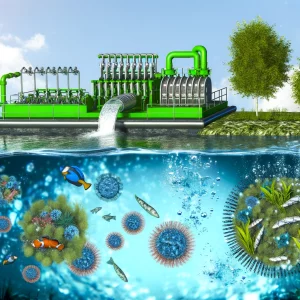 Bio Dredging Technology – In the face of escalating environmental challenges, the quest for sustainable and effective solutions to water pollution and sedimentation has led to the advent of Bio Dredging Technology. Unlike conventional dredging methods that rely on mechanical removal of sediments, bio dredging technology employs a more nuanced, eco-friendly approach. This technology harnesses the power of microorganisms to digest and convert harmful substances into benign byproducts, offering a promising path to waterway restoration.
Bio Dredging Technology – In the face of escalating environmental challenges, the quest for sustainable and effective solutions to water pollution and sedimentation has led to the advent of Bio Dredging Technology. Unlike conventional dredging methods that rely on mechanical removal of sediments, bio dredging technology employs a more nuanced, eco-friendly approach. This technology harnesses the power of microorganisms to digest and convert harmful substances into benign byproducts, offering a promising path to waterway restoration.
Understanding Bio Dredging Technology
Bio dredging technology is based on the principle of bioremediation – the use of biological agents, like bacteria, fungi, or plants, to remove or neutralize contaminants in a given environment. In the context of water bodies, specialized microbes are introduced or stimulated to grow, targeting the organic matter and pollutants that contribute to sediment build-up and water quality degradation. These microbes work by breaking down unwanted substances, including excessive nutrients, hydrocarbons, and heavy metals, thus cleansing the water and restoring the natural balance of the ecosystem.
The Dual Benefits of Bio Dredging: Environmental and Economic
Environmental Advantages
The primary appeal of bio dredging technology lies in its environmental benefits. By relying on natural processes, bio dredging minimizes the ecological footprint of restoration projects. It preserves aquatic life and habitat, reduces the risk of harmful algal blooms by controlling nutrient levels, and improves overall water quality without the disruptive impact of physical dredging operations. Moreover, bio dredging contributes to carbon sequestration, as the process of biodegradation involves the microbial conversion of carbon into biomass, further aligning with global climate change mitigation efforts.
Economic Efficiency
Beyond its environmental merits, bio dredging technology stands out for its cost-effectiveness. Traditional dredging methods can be prohibitively expensive, requiring heavy machinery, significant labor, and often complicated logistics for sediment disposal. Bio dredging, on the other hand, reduces these costs by leveraging the self-sustaining nature of microbial ecosystems. The reduced need for equipment and labor, coupled with the avoidance of disposal issues, makes bio dredging an economically viable option for many communities and industries seeking to manage water bodies sustainably.
Applications of Bio Dredging Technology
Bio dredging technology finds relevance in a wide array of applications, from urban water management and agricultural runoff treatment to industrial waste mitigation and habitat restoration. In urban settings, it helps maintain clear water in lakes and ponds, improving aesthetics and recreational value while preventing flooding. For agricultural and industrial runoff, bio dredging offers a way to treat water contaminated with pesticides, fertilizers, and other pollutants, safeguarding downstream ecosystems and water supplies.
Overcoming Challenges: Technical and Regulatory Hurdles
Despite its advantages, the adoption of bio dredging technology faces certain challenges. Technical hurdles, such as the need for precise microbial selection and cultivation, require advanced knowledge and expertise. Ensuring the efficacy and safety of these microbial treatments, especially in diverse environmental conditions, remains a priority. Furthermore, regulatory barriers can impede the widespread implementation of bio dredging, as approval processes for the use of bioengineered organisms in open environments are stringent and complex.
The Future of Bio Dredging Technology
Looking ahead, the future of bio dredging technology is bright, with ongoing research and innovation set to expand its capabilities and applications. Advances in genetic engineering and microbial ecology promise to enhance the efficiency and specificity of microbial treatments, enabling the targeted remediation of a broader spectrum of pollutants. Moreover, growing environmental awareness and the global push for sustainability are likely to drive increased adoption and regulatory support for bio dredging projects.
As technology advances, so does the potential for integrating bio dredging with other sustainable water management practices, such as constructed wetlands and phytoremediation, creating comprehensive systems for water quality improvement and ecosystem restoration. This holistic approach not only amplifies the benefits of bio dredging but also contributes to a broader strategy for addressing the environmental challenges of the 21st century.
Conclusion
Bio dredging technology represents a significant leap forward in our ability to manage and restore aquatic ecosystems in a sustainable, cost-effective manner. By harnessing the power of natural processes, this innovative approach offers a solution to the pressing issues of sedimentation and pollution, with the potential to transform waterway maintenance and environmental conservation. As we continue to explore and refine bio dredging technology, it holds the promise of a cleaner, healthier future for our planet’s water bodies, underscoring the importance of investment and research in this vital field.
